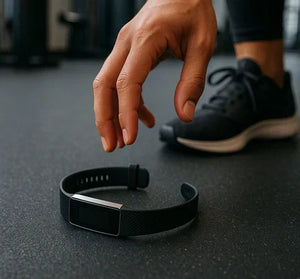When your watch band for your Apple Watch starts looking a little grubby, it is only natural to wonder whether you can just throw it into the washing machine for a quick and convenient clean. After all, it is something you wear every day, often when you are working out and even sleeping, so it makes sense that it might need a deeper refresh from time to time.
But can you actually put your Apple Watch strap in the washing machine? The simple answer is no, and doing so could easily ruin the strap. While it might seem harmless, machine washing can damage both the material and the delicate connectors that attach to your device.

So, let’s explore exactly why machine washing is such a bad idea and what can happen to different types of straps, and what to do instead if yours needs a clean.
Why You Should Never Machine-Wash an Apple Watch Strap
Straps for an Apple watch are made from carefully engineered materials specially designed for comfort and flexibility, but not for the harsh environment of a washing machine. During a cycle, your strap would be exposed to levels of heat and detergent, both of which can compromise its structure and shorten its lifespan considerably.
The washing machine may seem like a very convenient option, but the combination of water pressure and chemical exposure can permanently alter the feel and fit of your watch strap. Even a short cycle on a gentle wash can be enough to cause issues that are not visible immediately.
For example, the strap might look fine when you first remove it from the machine, but the materials could have become weakened, leaving it more likely to tear or detach from the watch face later on. The metal connectors can also corrode or lose their tightness, which could put your Apple Watch itself at risk of slipping off your wrist while you are wearing it.
So, while a washing machine might clean a T-shirt, it is the worst possible way to treat a watch strap designed for precision and comfort.

Why Each Strap Material Reacts Badly to Machine Washing
Different types of watch straps for the Apple Watch are made from different materials, each with its own benefits, but also with its own vulnerabilities. Here is how your machine washing can affect each type of material.
Silicone and Sport Straps
Classic Silicone (or Apple’s fluoroelastomer sport bands) is flexible and also fully water-resistant, which understandably can give some users the impression that it is safe to machine wash. Unfortunately, this is not the case.
In a washing machine, silicone straps can be exposed to temperatures that exceed what the material has been designed to handle. Prolonged exposure to hot water can cause it to lose elasticity, meaning it may not fit as snugly onto your device afterwards. The constant spinning motion can also create micro-tears in the material, making the strap feel a little sticky or uneven over time.
The detergent then poses another problem. Most laundry detergents are formulated for textiles and not synthetic rubbers, which means they can break down the protective surface coating. This can lead to dulling, discolouration, or a tacky texture that feels uncomfortable against your skin.
A better approach is to clean silicone straps by hand using a mild soap and water, a process that takes just a minute or two and avoids all these risks completely.
👉 Read the full guide for cleaning silicone wristbands for your Apple Watch correctly
Nylon and Fabric Straps
Nylon straps are popular because they are ultra-lightweight and breathable, but their woven texture makes them particularly unsuitable for washing machines. When nylon gets exposed to high-speed agitation, it can stretch or start to fray very quickly, especially around the edges where stitching is much more vulnerable.
The fibres can also absorb detergent residues, which may cause skin irritation when the watch band is worn again. In some cases, the strap may shrink or warp slightly, meaning it no longer sits comfortably or evenly on your wrist.
Even if you use a laundry bag or wash on a delicate cycle, the constant movement can still pull on the fabric weave and weaken the threads over time.
Instead, the safest way to give your nylon wristband a refresh is with a gentle hand clean using some mild soap, warm water, and a soft brush, keeping the structure intact while removing dirt effectively.
Leather Straps
Leather straps for an Apple Watch should never go near a washing machine. Leather is a natural material that absorbs moisture, and once saturated, it can lose its shape and stiffen permanently. The high-speed motion of a wash cycle will also scuff and stress the surface, stripping away the oils that give leather its smooth and supple feel.
Even cold-water cycles are still harmful because the leather’s fibres expand when wet, then contract unevenly as they dry. The result is a warped and brittle strap that will feel rough and look worn out.
Detergents can make matters even worse by removing the protective coating and leaving visible stains or patches. In short, machine washing leather does not clean it; it completely ruins it.
If your leather strap needs refreshing, the best option is to wipe it gently using a damp cloth and use a specialist leather cleaner or conditioner when necessary.
Metal and Stainless Steel Straps
Metal straps seem robust, but they are also extremely unsuitable for any machine washing. The tumbling motion of the drum can cause the strap to bang against hard surfaces, leaving scratches and dents in the links.

Washing machines also introduce the risk of rust or corrosion. Even stainless steel is not completely immune to oxidation, especially when exposed to detergents and moisture. Any decorative coatings, such as black or gold plating, will also likely peel under the abrasive conditions of a wash cycle.
Another issue is residue buildup: detergents and fabric softeners can leave behind films that dull the metal’s shine. The result is a strap that looks older and feels rougher than before.
A simple hand wipe with a damp cloth is always a far safer option if you own metal bands, followed by air drying to maintain their finish.
The Hidden Risks of Machine-Washing an Apple Watch Strap
Aside from visible damage to your watch band, there are a few less obvious reasons to avoid any machine washing.
One of the biggest concerns is moisture retention. Even after a wash cycle, straps, especially nylon or leather ones, can hold onto moisture deep within their fibres. This creates an ideal environment for bacteria, which can lead to unpleasant, smelly odours or even skin irritation when you wear the strap again.
Another issue is metal corrosion. The small connectors that attach your strap to your smartwatch are usually made from stainless steel or aluminium. When these parts are exposed to soapy water for extended periods of time, they can corrode or lose their smooth locking action. A loose connector might not seem serious at first, but it increases the risk of your Apple Watch slipping off during everyday wear.
Finally, machine washing simply is not worth the gamble. While it might save you a few minutes when you are in a rush, it can easily shorten your strap’s life or leave you needing a replacement far sooner than expected.

The Better Way to Keep Your Strap Fresh
If your Apple Watch wristwear is starting to look worse for wear, there is a much safer approach than just chucking it in the washing machine. A quick hand clean using mild soap and water is more than enough to restore freshness for most materials, and it will not cause any long-term harm.
For specific cleaning instructions, FitstrapsUK has detailed guides on how to clean different types of material straps, from silicone to leather and everything in between. These resources offer step-by-step advice to help you clean your strap properly without risking damage.
And if your strap is already way past saving, perhaps it is stretched or faded, then replacing it is often the easiest and most satisfying solution.
When Replacement Is the Right Choice
Over time, even the most carefully maintained strap will start to show its age. It is only natural that materials wear down and colours start to fade. Rather than trying to rescue a strap that is well beyond repair, it is often better to invest in a high-quality replacement that feels new and secure.
That is where FitstrapsUK comes in to help. With an extensive collection of replacement strap styles for the Apple Watch, in various materials and colours, you can easily find an option that matches your lifestyle. Whether you are looking for something compact and stylish for work or something more sporty for your training, we will have something just for you.
Each strap is designed for a device-specific fit and made from premium materials that combine comfort with durability. So, when your old strap has had its day, upgrading with FitstrapsUK is the simplest way to give your Apple Watch a fresh start.

Final Thoughts: Keep the Washing Machine for Your Clothes
So, can you put an Apple Watch strap in the washing machine? The answer is a definite no. While it might seem like a real timesaver, it is one of the quickest ways to damage your strap and shorten its lifespan. The levels of heat and the detergent used will work together as a dangerous double act against the delicate materials that make Apple watch-ready wristbands so comfortable and stylish.
A gentle hand clean is always the much safer route, and if your strap is completely beyond saving, a new one from FitstrapsUK will give your watch that brand-new feel again.
It is a small piece of advice, but it can save you the cost of a new strap (and possibly your Apple Watch itself).
FAQs
Can I wash my Apple Watch strap on a gentle cycle or inside a laundry bag?
No. Even a gentle cycle involves heat and motion that can distort materials or damage connectors. Always clean your watch band by hand instead.
What happens if I accidentally wash my strap in the machine?
Firstly, let it air dry completely before using it again, then check for any warping around the edges or loosened connectors. If there is any damage, don’t risk your device; it is best to replace it.
Why do people say their strap survived the washing machine?
Some straps might appear fine immediately afterwards, but repeated washes or exposure to the harsh detergent eventually cause degradation that is not fully visible at first.
Which watch straps are most vulnerable to machine washing?
Leather and nylon straps are the most sensitive, but even silicone and metal can be damaged by the combination of heat, friction.
 Can You Put an Apple Watch Strap in the Washing Machine?
Can You Put an Apple Watch Strap in the Washing Machine?
 Do Apple Watch Straps Fit Other Watches?
Do Apple Watch Straps Fit Other Watches?
 Best Apple Watch Band for CrossFit: The Complete Guide for Serious Training
Best Apple Watch Band for CrossFit: The Complete Guide for Serious Training
 Finding the Best Fitbit Band for Sleeping
Finding the Best Fitbit Band for Sleeping
 Finding a Christmas Apple Watch Strap: Celebrate the Season in Style
Finding a Christmas Apple Watch Strap: Celebrate the Season in Style
 Why Does My Fitbit Strap Keep Falling Off?
Why Does My Fitbit Strap Keep Falling Off?
 Adjusting Your Apple Watch Band For A Better Fit
Adjusting Your Apple Watch Band For A Better Fit




